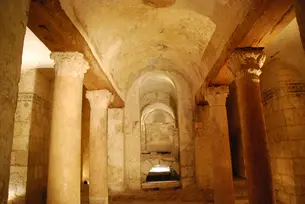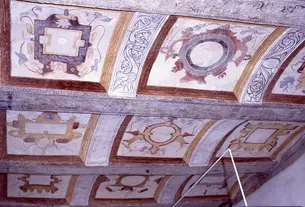Early cap ceilings and their distribution
Content and aims
From today's perspective, cap ceilings have a reputation for being ordinary, even banal. In the form of Prussian caps, they began a triumphal procession as a ceiling construction in Germany with industrialization from the second half of the 19th century. The inflationary use until the 1st third of the 20th century made the construction generally known. Hardly any stable or farm building of that time, from the Baltic Sea to the Alps, does without these ceilings.
The combination of brick and iron made capped ceilings the epitome of Wilhelminian building construction. These mass-produced building materials mark the beginning of industrial construction in Germany. The role of the railroad was twofold. On the one hand, it enabled the extensive transportation of these building materials over long distances, and on the other hand, the rails that were taken out of service were themselves used as iron girders in many a capped ceiling.
However, this mass phenomenon obscures the fact that capped ceilings were not an invention of the 19th century.
Vault technology
Ceilings were made well before the 19th century. The older cap ceilings usually have wooden beams as longitudinal beams, thus they have stone vaults and wooden components. An advantage of the mixed construction is the significantly lower construction height compared to classical vaults, and the solid caps in turn have much better fire and moisture resistance compared to purely wooden ceilings. However, the disadvantages of the basic flammability and moisture susceptibility of the wooden beams remain. The same applies to the higher construction costs of a solid ceiling compared to a pure wood ceiling or a ceiling with clay fill. However, the mixed construction significantly reduces these material-specific disadvantages.
The relatively simple construction with low overall height, relatively good fire protection and good moisture resistance has therefore characterized this ceiling construction from the very beginning.
Construction process, building materials
The first step in the process is to install the ceiling joists; this can be done either in conjunction with the construction of the exterior wall or subsequently. The ceiling beams usually have lateral notches as supports and abutments, thus forming an ideal bearing for the inclined first brick of the masonry cap. As a rule, the ceiling beams lie side by side with a spacing of 40 - 90 cm. A wider axial dimension does not make sense, as otherwise the cap would overhang the top edge of the floor joist.
The caps themselves are made using falsework. After the wooden beams have been installed as vault supports, the next step is to fill the ceiling bays. The bricks are placed on a formwork in longitudinal rows from above and then mortared from the top side as well. As soon as the mortar has hardened, the falsework can be moved to the next beam field, so that the work can be carried out quickly. Making the copings from bricks was probably the most common method of construction. However, for the town hall in Blankenburg and the residential stable house in Herrnberchtheim, small quarry stones can be found instead of bricks.
A completely different solution is found in the cattle barn of Frankenberg Castle near Uffenheim (1794): The caps are cast from plaster screed.
Historical development, present state of knowledge
According to the current state of knowledge, German cap ceilings are an early modern transfer of technology from France. The oldest French example is the three-part ceiling in the crypt in Saint-Germain in Auxerre from the middle of the 9th century. Violett-le-Duc, in his Dictionnaire raisonné de l’architecture fran?aise du XIe au XVIe siècle , has handed down a secular example from the 15th century from Chartres. Duke Erich II of Brunswick-Lüneburg demonstrably built Landestrost Castle under the influence of French builders. In Germany, this ceiling form with parallel longitudinal caps can only be traced back to the Middle Ages as a purely wooden construction.
The oldest German examples from the 16th century are found in the north. In 1573-1584, Duke Erich II of Brunswick-Lüneburg had Landestrost Castle in Neustadt am Rübenberge built with cap ceilings. This was followed somewhat later by the town hall in Blankenburg in the Harz Mountains. Other north German examples are found in the Amtshof in Ottersberg in 1585/86 (d) and in the Zinskornscheune of Syke Castle, c. 1592.
Early southern German examples would be the town hall in Geisenfeld (1626), Thurnau Castle (1675), Weihenlinden rectory, Rosenheim district (c. 1680), Schwarzenberg Castle (brewery c. 1700), Unterschwaningen Castle (side rooms, 1715-19). The hooded ceilings were thus introduced in the principality of Ansbach by 1715 at the latest and subsequently became widespread in the region, even in simple agricultural stables.
Further examples are known so far for the Aachen area and the neighboring Benelux countries.
Question
Regardless of the question of formal precursors of the stone cap ceilings, one should not hastily attribute the emergence of the masonry cap ceilings to aesthetic considerations or the will to form alone.
At the latest, the use of massive masonry copings in utility rooms from the 17th century onwards proves their functional or structural value, independent of their form. In particular, the more recent Franconian examples make it clear that cap ceilings were applied primarily for structural considerations. Here, they are found predominantly in utility rooms with high moisture loads or fire hazards. The recording of further examples is necessary in order to understand this construction in all its diversity and the various lines of development. Important information on the temporal and spatial distribution of cap ceilings is still lacking.
Current publication
Wenderoth, Thomas: Gerettet: Der ehemalige Gasthof Stern in Sugenheim, Mühlstra?e 2: Baugeschichte, Denkmalpflege, Instandsetzungsma?nahmen. In: Denkmalpflege-Informationen, Ausgabe B 142, München 2009, S. 15-16.
Wenderoth, Thomas: Frühe Kappendecken und ihre Verbreitung in Franken. In: May, Herbert/ Waldemer, Georg/ Weidlich, Ariane (Hrsg.): Neues aus der Hausforschung in Bayern (Quellen und Materialien zur Hausforschung in Bayern, Bd. 16), Bad Windsheim 2015, S. 177-206.
Pictures
Click on the images to enlarge.



